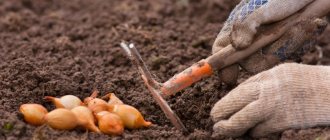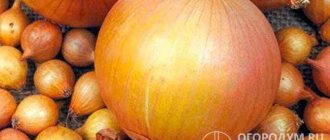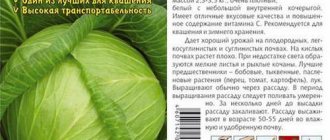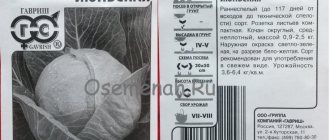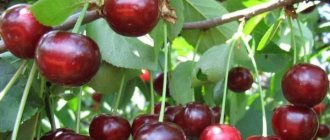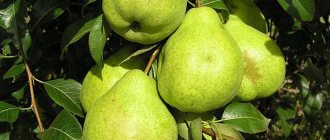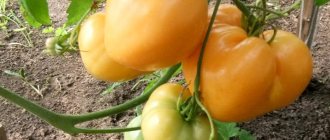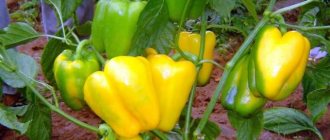Chemical composition
No wonder they say that “onions cure seven diseases.” It contains phytoncides, which give it its pungent taste. These substances kill pathogenic microbes.
In addition to them, onions contain:
- Vitamins C and group B.
- There is potassium and phosphorus.
- Magnesium, iron.
It contains a lot of microelements such as boron, silicon, cobalt, iodine and zinc. There are also phytosterols that protect against atherosclerosis.
On a note! In terms of vitamin C content, the Centurion onion variety stands out among the rest. 100 g contains 12 mg, which is one and a half times more than other varieties.
Appearance and taste characteristics
The bulb of this variety is small. Its weight is from 100 to 150 g. The shape is wide-obovate, the scales are golden, the flesh is white, dense. The leaves are dark green.
The taste characteristics of Centurion onions are excellent.
- Moderately spicy, incredibly aromatic pulp with piquant flavor tones is perfect for eating raw.
- After boiling or frying it becomes sweet, but without being cloying.
- This onion is also wonderful when marinated or in side dishes.
- When fried, it acquires a bright golden color and a wonderful aroma.
Advantages and disadvantages
The advantages include more even dimensions than the Stuttgarter and excellent keeping quality. In good conditions, this onion lasts 8 months, which means you can enjoy this healthy vegetable all year round, because already in April the Centurion onion produces its first feathers when planted before winter.
- It is distinguished by 100% seed germination and seed germination.
- Quite unpretentious, grows well in cool weather and hot weather.
- Tolerates light frosts and drought, although in wet summers it can suffer from powdery mildew.
The Centurion onion variety has perhaps the only drawback. Like all F1 hybrids, seeds and onion sets have to be purchased again from trusted sellers. If you buy from random people on the market, you cannot hope that it will be the Centurion.
Anything can grow from the seeds that appear on it. Fortunately, high-quality onion sets are supplied by Dutch and domestic companies.
It differs from other varieties in its early ripening, rather large size, and very high yield in any conditions.
Selection of planting material
This onion variety is grown for 2 years. In the first year, seeds are sown to germinate onion sets. In the second year, the seedlings are planted and a full-fledged fruit is already formed from it.
Sevok
Onion sets are small root vegetables.
To get a high yield, it must have the following features and requirements:
- bulbs up to 2 cm in diameter;
- fruits are dry and rustling;
- straw-colored husk;
- without damage.
We recommend reading about the vitamin composition of onions and their beneficial properties.
Seeds
Selecting a quality seed is an important step in growing Centurion onions. Since this variety is a hybrid, it is better to purchase seed in a special store. But if it was selected independently, then before sowing it must be sorted out, weak and unsuitable seeds must be discarded.
Features of planting and care
The onion variety Centurion has a two-year cycle. In the first year, an onion set grows from the seeds, and the next year - a full-fledged large onion.
Growing from seeds
Most gardeners prefer to purchase onion sets right away. The need to grow sets from seeds may arise if they are difficult to find in gardening stores in your area. Seeds are easy to buy on the Internet. The Centurion onion set will definitely grow from them . It’s a little troublesome, but it pays off with the high quality of planting material and good agricultural technology.
- At the very beginning of March, the seeds are planted into seedlings in boxes.
- Before sowing, they are treated with a weak solution of potassium permanganate.
- Then they are soaked in water with the addition of root or another stimulant, and placed in a damp cloth for three days.
- After the sprouts appear, they are sown to a depth of 3 cm at a distance of 10 cm from each other.
Advice! If there is a lack of sunlight, seedlings need to be illuminated with a fluorescent lamp or special lamps.
Centurion onions, the description of which interests many gardeners, can also be grown without seedlings. To do this, the seeds are soaked in the same way; before planting, they need to be slightly dried.
- Planting onto a pre-prepared bed is carried out in mid-April-early May after the soil has warmed to 15°C.
- Furrows about 4 cm deep are made at a distance of 20-25 cm between rows.
- In the grooves you need to make indentations every 10-15 cm.
- The bed is watered and seedlings or seeds are carefully planted, then sprinkled with earth and lightly compacted.
Further care consists of timely watering, especially in the first month after planting seedlings, weeding, loosening, and fertilizing. The harvested seedlings are dried in the sun and put away for winter storage, if winter sowing is not planned.
Planting onion sets
The sets are planted in exactly the same grooves, but the distance between them should be increased to 25 cm. The grooves are watered and the sets are placed in them, deepening it no more than 4 cm. Sprinkle with earth or peat and tamp lightly.
Pre-winter sowing of onion sets
Centurion onions can be planted before winter. This is one of the best varieties of winter onions. Its high frost resistance allows it to be planted either in the Crimea or in Siberia.
Important! For Centurion onions, planting before winter is preferable to planting in spring.
It allows you to get a larger harvest, and 2-3 weeks earlier. Such a bed will also please you in the spring, because where there was snow just recently, there will already be juicy, vitamin-rich greens.
Interesting on the topic: The best varieties of winter onions: advantages, description + photos
Winter onions Centurion should be planted 3 weeks before persistent cold weather. It is quite difficult to determine the moment, because autumn can be different.
- In the middle zone, the suitable time is usually from October 5 to October 20.
- In the northern regions it begins in mid-September.
- In the south it may even occur in the second half of November.
You can focus on the air temperature. If it stays no higher than 6°C for several days, on the soil surface at night -1 -2°C, and according to the forecast no significant warming is expected, then you can plant Centurion onions before winter. It will have time to take root, but will not germinate.
The bed should be placed in a sunny place and raised. You need to fill the soil with organic matter in advance. For Centurion onions, the planting scheme for winter sowing is the same as described earlier, and care in the spring is usual. In winter, it is useful to sprinkle the garden bed with mulch, which is carefully raked away from the bulbs after the snow has melted. In cold and snowy regions it is worth covering with suitable material.
Among winter onion varieties, Centurion is one of the best. The loss does not exceed 10-15%, and often all the bulbs survive and begin to grow in April.
Watering
Until the end of June, you need to water the onions every week. 1 sq.m will require 7-8 liters of water. Do not water with cold water from a well or borehole, otherwise the onion will get sick. The water needs to be warmed in the sun.
From July, watering is done less frequently and not so abundantly, and 3 weeks before the harvest ripens, watering is not only unnecessary, but will also damage the keeping quality of the bulbs.
Loosening the soil and weeding
The bed with onions needs to be weeded in a timely manner. Weeds take away nutrients and moisture from plants and also attract pests. It is especially important to prevent the appearance of weeds after planting seeds or seedlings. They can completely choke out weak shoots.
Air access to the roots is no less important. You can't do without loosening here.
This must be done carefully, preferably soon after watering, but at least 3 times a month. If a crust forms on the ground, the growth of the bulbs is delayed, and then you should not expect a good harvest.
Feeding
Onions will need the first feeding 2-3 weeks after planting. At this time, a sufficient amount of nitrogen is necessary for the growth of green mass.
- The best nitrogen fertilizers are urea and ammonium nitrate.
- Onions need phosphorus, but less potassium is required at the beginning of growth.
- The amount of fertilizer depends on the soil. But in order not to be mistaken, it is better to take 40 g of urea, 40 g of double superphosphate and 20 g of potassium sulfate per bucket of water.
The second feeding is desirable 1.5-2 weeks after the first. The Centurion onion responds best to organic matter.
- A bucket of water will require 0.8 kg of mullein.
- If you have bird droppings, it is useful to let it ferment; for this, 0.7 kg is diluted in 5 liters of water and left for several days.
- Before feeding, this slurry is diluted with water 2-3 times, and then watered with water to wash it off the leaves.
- You can also use ash, which is taken at the rate of 200 g per bucket of water.
Advice! If there is nowhere to get organic fertilizers, then you can use mineral ones, only the dose of nitrogen is reduced by 1.5 times, and the dose of potassium, on the contrary, is increased by 1.5 times.
But any gardener counting on decent harvests always has on hand such natural organic fertilizer as compost. Moreover, preparing it is not difficult. You can find out how to make proper, healthy and nutritious compost here .
The third feeding is desirable when 4 feathers appear. Nitrogen is no longer needed at this time. It stimulates feather growth to the detriment of bulb development. Take 30 g of superphosphate and potassium sulfate per bucket of water, but it is best to use ash.
When growing Centurion onions, two feedings are enough, but it is very useful to pour a weak solution of urea after the next picking of greens, taking 1 tablespoon of it per bucket of water. This will speed up the growth of new feathers.
Reviews
- I have been growing the “Centurion” variety in my garden for two years now. I would like to note that during all this time I have not regretted choosing this variety. Last year I harvested a record harvest for me - 7.3 kg. bulbs from 1 m2. I really like the fact that the variety is adapted for long-term storage. During cultivation, I noticed that the bulbs tolerate dry weather well. I use the harvested crops with great pleasure to prepare various dishes. I am very pleased with the variety. I recommend to everyone.
- Last year I purchased seeds of the Centurion variety for the first time. In the first year I grew a surprisingly large volume of onion sets. This year I planted seedlings and at the end of summer I received an excellent harvest of the above-mentioned variety. We managed to collect 8 kg. large bulbs from 1 m2. The grown bulbs have a beautiful appearance and a very piquant taste. Plants of this variety were practically not affected by diseases and responded well to fertilizing with organic and mineral fertilizers. During the process of its growth and development, the variety produces very little shoots.
- The variety has good resistance against major diseases. When grown on my own plot, I always get good yields. My record is 7 kg. from 1 m2. The grown crop is well stored and tastes great. I recommend everyone to grow only the “Centurion” variety. The effort and time spent on growing this variety will easily be justified by a good harvest. Tested for myself. Good luck.
- Good variety. I always know that I will get a good harvest if I use the Centurion variety seed. During the period of growth and development, plants are not picky about growing conditions. The main positive features of the variety are: resistance to drought and disease, high yield, good keeping quality of the grown crop. I liked the variety. I recommend to everyone.
Disease Control
The onion variety Centurion is quite resistant to disease; Dutch breeders have worked hard on this. But it was not possible to give onions resistance to powdery mildew. Therefore, when white spots appear on the leaves, urgent measures must be taken.
- All diseased leaves are removed and burned.
- At the very beginning of the development of the disease, you can try to save the plants with phytosporin, purple solution of potassium permanganate or iodine.
- 10 ml of iodine tincture is diluted in a bucket of water and watered over the onion bed.
- A good old Bordeaux mixture also helps.
Alternaria blight is another fungal disease that can affect Centurion onions. The disease develops in warm, humid weather, especially in areas where pests or other fungi have already worked. Elongated, watery spots appear on the leaves, soon turning purple or brown.
Important! When affected, the keeping quality of the bulbs is greatly reduced, but at the very beginning you can cope with the fungicides Ridomil Gold, as well as Bravo and Pergado F.
Pests
Of the pests, Centurion is affected by onion moth and onion fly.
In May, inconspicuous brown butterflies can be seen above the onion beds. This is an onion moth that can cause considerable damage to the crop.
- In addition to chemistry, folk remedies cope well with it, especially tobacco or pepper infusion.
- If this is not at hand, then you can dilute the ash and spray the plants with the solution.
- All leaves affected by caterpillars are torn off and burned.
Attention! If the favorable moment is missed, then only complete cutting of the feathers can help. New ones will grow soon.
But it is better to plant carrots or mustard next to the onions in advance, the smell of which these creatures cannot stand. Carrots will also repel the onion fly that attacks the bulbs. Its invasions can be repeated 2-3 times per season.
To scare away the pest, it is useful to plant marigolds next to the onions, and spread wormwood or pine needles on the beds.
The same infusions that fight moths help to cope with onion flies, as well as ammonia, which you take 3 tablespoons per bucket of water. Kerosene mixed with sand, which is scattered between the rows, also repels them.
Beneficial features
Onions are a very necessary food product. But not only. It is also good for health, as it contains vitamins, minerals (fluorine, iron, iodine, zinc and others), phytoncides. Sugars, essential oils, organic acids, antioxidants.
A pungent taste and pungent odor indicate the presence of allicins. These are essential oils containing sulfur. Phytoncides exhibit powerful antimicrobial and antiviral effects. You can cut an onion, place it in the room, and this will be enough to clear the air of bacteria, viruses, protozoa, and fungal spores. Phytoncides kill Koch's bacillus and diphtheria. They also resist pathogens of dysentery and streptococcal infections. Onions are also anthelmintic, antiviral, hematopoietic, diuretic, expectorant, tonic, and restorative vegetable. If you include it in the menu daily, then:
- the digestive process is normalized;
- the level of immunity will increase;
- Blood pressure will gently decrease;
- blood cholesterol levels will decrease;
- libido is normalized;
- blood sugar levels will decrease;
- metabolism is activated;
- sleep is normalized.
Daily consumption of onions is a means of preventing cardiovascular and cold diseases. And also hypovitaminosis.
Centurion bulbs are stored almost until the new harvest, so this storehouse of vitamins and microelements will be at hand for quite a long time if you follow the rules for storing onions at home.
Harvest and storage
After the feathers have turned yellow and died, choose a hot sunny day and begin harvesting. This happens in the second half of July.
- The pulled out bulbs are kept in the sun until evening, and then dried in the shade for 2-3 days.
- The bulbs are examined, and if they are found damaged by diseases and pests, they are sent to the fire.
- Leaves of healthy ones are cut off, leaving 5-6 cm, tied into braids and put away for winter consumption in a dry, dark place.
Another method is probably familiar to you. The onions are placed in nylon stockings and hung.
You can also store the bulbs in the cellar, if it is dry enough, in bulk or in boxes with dry sand.
Onion harvesting
A sign that it is time to harvest the onion is its dried neck. During this period, she is no longer able to hold the feathers, and they fall to the ground.
The above-ground part of the plant should already be dry at the time of harvest. If onions are harvested ahead of time, they will rot during storage. Late harvesting can also present an unwanted surprise, which manifests itself in premature germination of the bulbs.
When the root crops have already been collected, they must be dried. It is better to do this in sunny places, spreading the bulbs in one layer. In rainy weather, you can use the canopy.
Before storing onions, they are trimmed and placed in wooden boxes. They are lowered into the basement, since in residential areas the root crops will begin to rot or sprout. The ideal temperature for storing onions is no higher than +5°C.
The reviews about the Centurion bow are simply wonderful. Many people like its taste and shape of the fruit. People note that root vegetables store well. Gardeners who grow onions for sale are satisfied with its productivity and early ripening. They are impressed by the beautiful, lush greenery that is not damaged by disease.
